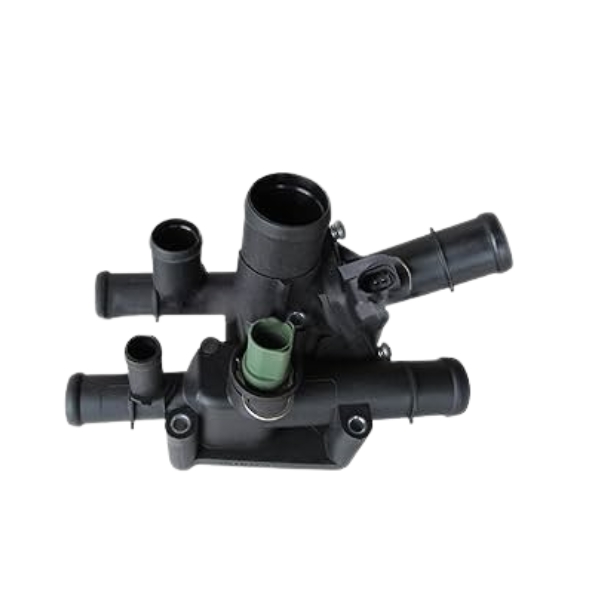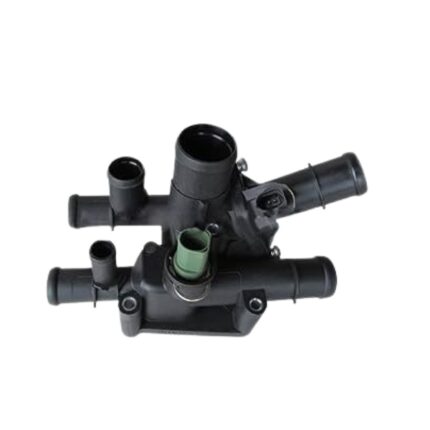Get AUDI A3 Sportback (8PA) Thermostat Housing 06A121111A in Kenya
The thermostat housing is a vital component of a vehicle’s cooling system. Its primary role is to house the thermostat, a temperature-regulating valve that ensures the engine operates within an optimal temperature range. The thermostat housing serves as the connection point between the engine and the radiator, directing coolant flow and maintaining a balanced engine temperature. This article delves into the thermostat housing’s functions, benefits, signs of wear, and maintenance tips.
Function of the Thermostat Housing
The thermostat housing is a robust structure typically made from materials like plastic, aluminum, or cast iron, designed to hold the thermostat in place while ensuring coolant flows smoothly between the engine and the radiator. It performs several crucial functions, including:
- Housing the Thermostat:
- The primary function of the thermostat housing is to protect and support the thermostat. The thermostat is a temperature-sensitive valve that opens and closes depending on the engine’s temperature, allowing coolant to flow to the radiator when necessary.
- Directing Coolant Flow:
- The thermostat housing acts as a junction between the engine, radiator, and sometimes the water pump. It channels coolant from the engine to the radiator when the thermostat opens. This flow is essential for keeping the engine within the optimal operating temperature range (typically around 195-220°F or 90-105°C).
- Sealing Coolant:
- The thermostat housing creates a tight seal between the coolant pathways to prevent leaks. A gasket or O-ring is often used between the housing and the engine to ensure the system is leak-proof. This sealing is crucial for maintaining consistent pressure and flow within the cooling system.
- Heat Dissipation:
- Some thermostat housings are designed to help dissipate heat from the coolant. Aluminum or metal housings, for example, can assist in transferring heat away from the coolant, contributing to more efficient temperature management.
- Engine Protection:
- By ensuring the coolant flows only when needed, the thermostat housing plays a role in preventing the engine from overheating. When the engine reaches its optimal temperature, the thermostat opens, allowing coolant to flow to the radiator for cooling and back to the engine to absorb excess heat.
Types of Thermostat Housings
The material and design of thermostat housings vary depending on the vehicle make and model:
- Plastic Thermostat Housing:
- Modern vehicles often come with thermostat housings made from high-temperature-resistant plastic. These housings are lighter and cheaper to manufacture, but they are more prone to cracking and damage over time.
- Aluminum Thermostat Housing:
- Aluminum housings are more durable and resistant to high temperatures. They are commonly found in performance or heavy-duty vehicles. While more expensive, aluminum offers better longevity compared to plastic.
- Cast Iron Thermostat Housing:
- Older vehicles and heavy-duty trucks may use cast iron thermostat housings due to their strength and resistance to warping. However, they are susceptible to rust and corrosion over time, especially if not properly maintained.
Benefits of the Thermostat Housing
The thermostat housing offers several key benefits that help the engine run efficiently and extend its life:
- Efficient Temperature Regulation:
- By housing the thermostat, it ensures that the engine’s temperature is controlled. The thermostat opens and closes based on the engine’s temperature, directing coolant to the radiator when necessary. This prevents overheating and ensures that the engine operates within its ideal temperature range.
- Prevents Overcooling:
- Just as it prevents overheating, the thermostat housing ensures that coolant does not flow unnecessarily, which could lead to overcooling. If an engine runs too cold, it can suffer from increased wear, reduced fuel efficiency, and higher emissions.
- Durability:
- Depending on its material, the thermostat housing can be highly durable, especially in aluminum or cast iron models. These housings are built to withstand extreme temperature changes and the pressure generated by the cooling system.
- Protection Against Coolant Leaks:
- The housing acts as a seal for the coolant flow between the engine and the radiator. A well-maintained housing helps prevent leaks, which can result in coolant loss and potential engine damage due to overheating.
- Engine Performance Optimization:
- Maintaining the engine within the optimal temperature range ensures better combustion efficiency, smoother operation, and reduced emissions. The thermostat housing plays a crucial role in achieving this by facilitating proper coolant flow when the engine gets too hot.
Signs of a Worn-Out or Damaged Thermostat Housing
Like any automotive component, the thermostat housing is subject to wear and damage over time. Several signs indicate that it might need repair or replacement:
- Coolant Leaks:
- One of the most obvious signs of a worn-out thermostat housing is coolant leaks. Leaks typically occur around the housing gasket, O-ring, or the housing itself if it’s cracked or damaged. You may notice coolant pooling under the vehicle or visible residue around the housing.
- Overheating Engine:
- If the thermostat housing is damaged, the thermostat might not function correctly, leading to engine overheating. A faulty housing can prevent proper coolant flow, causing the engine to heat up rapidly. If the engine temperature gauge spikes, it could indicate a problem with the housing.
- Low Coolant Levels:
- A cracked housing or faulty gasket can result in coolant loss. If your coolant level keeps dropping despite refilling it, it’s important to inspect the thermostat housing for potential cracks, gaps, or leaks.
- Erratic Temperature Gauge Readings:
- A malfunctioning thermostat due to a damaged housing may cause inconsistent readings on the temperature gauge. The gauge may show extreme temperature fluctuations, signaling that the thermostat is not regulating coolant flow properly.
- Visible Cracks or Damage:
- Over time, plastic thermostat housings can crack due to exposure to high heat and pressure. In contrast, metal housings may develop rust, corrosion, or warping. A visual inspection may reveal obvious cracks, damage, or corrosion on the housing surface.
- Coolant Discoloration:
- A worn-out thermostat housing may allow contaminants to enter the cooling system, causing coolant discoloration. If the coolant appears rusty, oily, or murky, it could indicate that the housing or gasket is failing, allowing contamination.
- Steam from the Engine Bay:
- If the housing is leaking and coolant is escaping, steam might rise from the engine bay, especially after the engine reaches operating temperature. This is a clear indication of a cooling system issue, potentially caused by a damaged thermostat housing.
Thermostat Housing Maintenance Tips
Proper maintenance of the thermostat housing can prolong its lifespan and ensure the cooling system functions efficiently. Here are some key maintenance tips:
- Regular Inspection:
- Periodically inspect the thermostat housing for visible signs of wear, such as cracks, leaks, or corrosion. Pay attention to the area around the housing gasket or O-ring, as these seals are prone to failure over time.
- Monitor Coolant Levels:
- Regularly check coolant levels to ensure they remain within the recommended range. Consistently low coolant levels can indicate a leak from the thermostat housing or other parts of the cooling system.
- Replace the Thermostat When Needed:
- If the thermostat is faulty or stuck, it can affect the performance of the entire cooling system. Replace the thermostat if you notice issues with temperature regulation, such as the engine running too hot or too cold.
- Use the Right Coolant:
- Ensure that you’re using the manufacturer-recommended coolant type. Using the wrong coolant can lead to corrosion or damage to the thermostat housing, particularly if it’s made of aluminum or other sensitive materials.
- Tighten the Housing Bolts Properly:
- During maintenance or thermostat replacement, ensure that the bolts securing the housing are properly tightened. Overtightening can crack plastic housings, while under-tightening can lead to leaks. Always follow torque specifications when reinstalling the housing.
- Replace the Gasket or O-Ring:
- Over time, the gasket or O-ring that seals the thermostat housing may deteriorate, causing leaks. Replace these seals during regular cooling system maintenance to prevent leaks and ensure proper sealing.
- Flush the Cooling System Regularly:
- Flushing the cooling system periodically removes contaminants and debris that can damage the thermostat housing and other cooling system components. A clean cooling system ensures efficient operation and prevents corrosion buildup.
Conclusion
The thermostat housing is a small yet essential component in the cooling system, playing a critical role in maintaining engine temperature. By housing the thermostat and directing coolant flow, it helps prevent overheating and overcooling, both of which can significantly affect engine performance. However, thermostat housings are subject to wear, particularly due to extreme temperature changes and constant coolant flow. Recognizing the signs of a worn-out thermostat housing, such as coolant leaks, erratic temperature readings, or visible damage, allows vehicle owners to address issues promptly, preventing engine damage and costly repairs. Regular inspection, maintenance, and timely replacement of worn components can help ensure that the thermostat housing continues to function efficiently, keeping your engine running at optimal performance.
Follow us on Facebook for more parts.





Reviews
Clear filtersThere are no reviews yet.